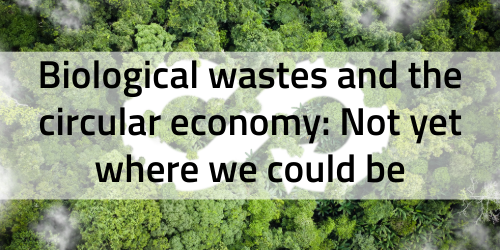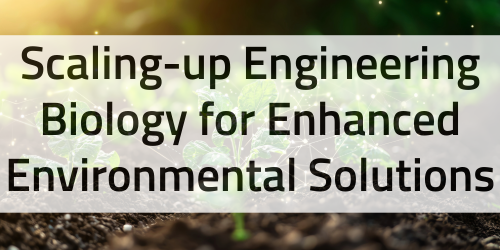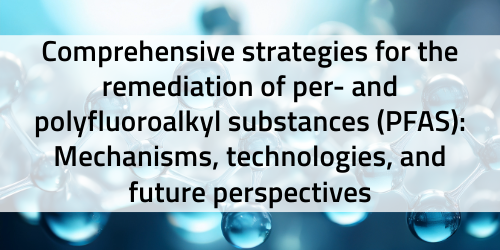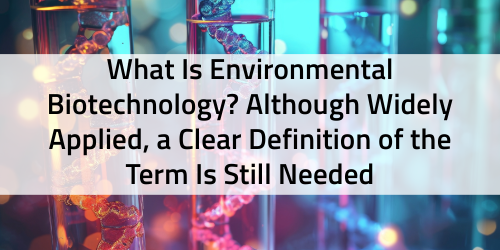Summary: An in-depth overview of how PFAS persists in the environment and the emerging methods to eliminate them. It reviews physical, chemical, and biological remediation approaches—such as adsorption, oxidation, and biodegradation—highlighting their strengths and limitations. The authors, many of whom are EBIC partners, emphasise that while current techniques can capture or break down PFAS to some extent, challenges like incomplete destruction, high costs, and scalability remain. The paper calls for integrated treatment systems, advances in biological pathways, and stronger regulatory frameworks to achieve effective, sustainable PFAS clean-up.
Summary: The authors, many of whom are EBIC team members, explore how the term Environmental Biotechnology is widely used yet lacks a consistent definition, which complicates funding, policy and cross-disciplinary collaboration. They review literature and engagement activities and find that while researchers generally recognise the field’s intent, interpretations vary. To address this, they propose a working definition: the use of biologically-mediated systems for environmental protection and bioremediation, including resource recovery and bioenergy when integral to system sustainability. They emphasise that any definition must remain flexible to keep pace with evolving science and applications.

Published: October 2025
BBC Future
Summary: Francis Hassard, Cranfield University, discusses the bacteria commonly found in shower heads, if they should be a cause for concern and what you can do to mitigate any potential risks.

Published: April 2025
Government Office for Science
Summary: Engineering Biology is a platform technology that has the potential to impact so many aspects of our daily lives. The Aspirations report uses 5 case studies to explore the future of engineering biology, including my contribution highlighting the use of engineering biology for sustainable mining, metal recycling and to support a circular economy. This narrative pulls together many research strands and includes my thoughts on future directions, such as scale up, commercialisation and societal impacts. The report really delves into the challenges that Engineering Biology could address and I look forward to the conversations it opens up, especially with policy makers and the public – Prof. Louise Horsfall, EBIC Theme 4 Lead & Chair of Sustainable Biotechnology at the University of Edinburgh.

Published: April 2025
Nature Communications
Summary: This Nature Communications paper explores how engineering biology can tackle environmental issues like bioremediation and pollutant monitoring. The authors, many of whom are EBIC partners, discuss exciting innovations, tech integrations with AI, and the hurdles of scaling up. They also cover biosafety and governance, plus strategies to boost the real-world adoption of engineering biology for a greener future.
Listen to an Ai podcast on the key findings and insights from the paper

Published: March 2025
Sage
Summary: Sigrid Kusch-Brandt and EBIC’s Sonia Heaven highlight the significant potential of biological wastes for a circular bio-economy, and delve into the gap between research innovations and their real-world application. This paper explores the reasoning behind this slow adoption, as well as the potential for driving innovation and making the field more attractive in order to accelerate the utilisation of these valuable solutions.

Published: January 2025
Nature
Summary: EBIC’s Ronan McCarthy’s brilliant work leveraging microbes in the bioremediation of plastics is featured amongst the top technologies to watch in 2025, as complied by the journal Nature, in their annual roundup of exciting innovations. Ronan’s work involves coaxing plastic-degrading bacteria to form dense biofilms on the surface of plastic fragments, allowing the bacteria to secrete enzymes onto the target plastics, without being washed away.

Published: December 2024
Chartered Institute of Water and Environmental Management (CIWEM)
Summary: Tailored microbes can efficiently remove pollutants like microplastics, hydrocarbons, metals and oils from water – so what’s stopping the water sector from embracing their potential? EBIC’s Frederic Coulon explores the tools, challenges and how EBIC is working on the safe scaling up of techniques from engineering biology for clean, sustainable, environmental solutions.

Published: November 2024
Cell – Trends in Biotechnology
Summary: This article reviews engineering biology approaches to manipulate bacterial biofilms. It highlights the potential of harnessing biofilms’ natural properties, such as self-repair and resilience, for various biotechnological applications, including bioremediation and biomanufacturing. The authors discuss various engineering targets, such as extracellular matrix components and quorum sensing, and explores tools for biofilm control and modification, including optogenetics. Finally, they showcase examples of engineered biofilms with enhanced functionalities and address the challenges and future prospects of this field.

Published: June 2024
ACS Publications
Summary: This viewpoint article advocates for scaling up synthetic biology (SynBio) to address environmental challenges. SynBio techniques, such as genome editing and the engineering of microbial factories, offer promising solutions for bioremediation and sustainable resource management. However, the authors highlight the need to overcome challenges in scaling up laboratory research, ensuring ethical considerations, and understanding the complex interactions within engineered microbial communities. The article emphasizes the importance of collaboration and the role of the UK’s Environmental Biotechnology Innovation Centre (EBIC) in fostering responsible SynBio development. Finally, the authors stress the need for standardization and robust tracking methods to improve the efficiency and transparency of the SynBio process.
Listen to an Ai podcast on the key findings and insights from the paper




